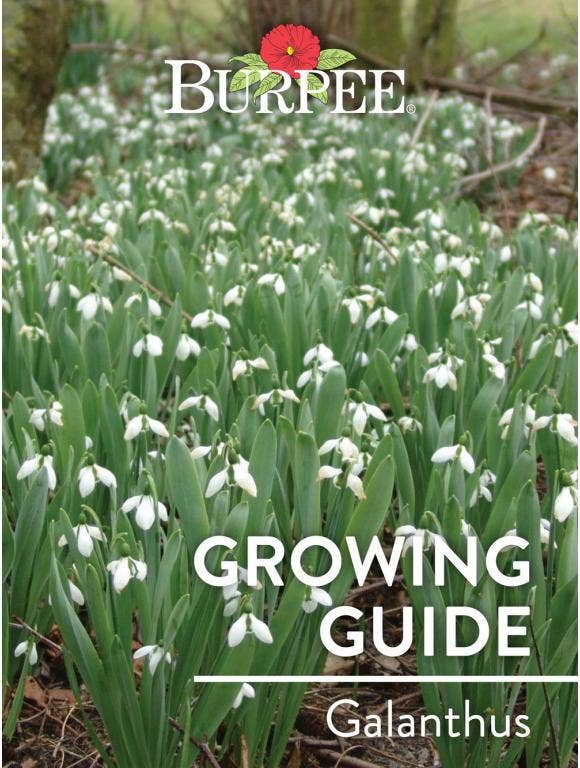
Planting Bulbs in Fall:
- Because your bulbs will probably be left where you plant them for several years, good soil preparation is highly desirable. Galanthus grows best in full sun to light shade in a light, well-drained soil enriched with organic matter. Loose, crumbly soil beneath a bulb encourages good growth and promotes drainage; it is a good idea to prepare the soil at least a few inches deeper than the recommended planting depth. Check the proposed site for standing water after a rainfall. If you must plant where the soil is known to remain wet, raise the soil level by 6-12 inches above the surrounding soil.
- It is a good idea to add fertilizer, such as bonemeal, when you prepare the soil. Be sure to mix the fertilizer into the soil so it does not come into direct contact with the bulbs.
- The general rule for planting is to cover the bulb with soil to 2 to 3 inches of soil. In very cold climates, or where the soil is very light and sandy, plant a little deeper. In heavy soils, or in areas with a high water table, plant slightly more shallowly. Plant all bulbs of a kind, when grouped together, at the same depth so they will bloom at the same time and attain the same height.
- For planting clumps of bulbs in beds and borders, dig a hole large enough to hold all the bulbs in one group or drift. Set them upright at the bottom of the hole, tops up (pointed side up), and space properly. Press the bulbs into the soil and cover with the prepared soil to the recommended depth. You can also use a trowel to dig individual holes.
- Galanthus should be planted 2-3 inches deep, 2-4 inches apart.
- After planting water thoroughly to settle the soil and to encourage the start of root growth. Sufficient moisture is vital to the health of your bulbs; lacking ample rain, it may be necessary to water new plantings once a week in fall. The roots will continue to grow in fall until the soil freezes.
- Be sure to mark where you planted your bulbs so you know where they are in spring.
- Add 1-3 inches of mulch for winter protection after the ground freezes.
How to Grow
- Flower bulbs also require watering after blooming, while the foliage is ripening. Water weekly if conditions are dry.
- In spring after flowering, do not cut the foliage off; the foliage is part of the perennial growth cycle. Allow it to die back naturally.
- Apply a fertilizer after the plants have finished blooming.
Growing Tips
- Galanthus can be left undisturbed for many years and will multiply.
- If you need to move them, dig them up and divide them just after they finish flowering.
Common Disease Problems
Botrytis: This fungus causes a grey mold on flowers, leaves, stems and buds causing the leaves to stick together. It thrives in cool wet weather conditions. Burpee Recommends: Remove affected plant parts, avoid watering at night and getting water on the plant when watering. Make sure plants have good air circulation. Contact your Cooperative Extension Service for fungicide recommendations.
Basal Rot: This fungus invades the bulb through the roots and basal plate. It causes premature streaky yellowing of the foliage and the basal plate is dark brown and dead. It is more prevalent in warm, moist soils. Burpee Recommends: Provide good drainage. Contact your Cooperative Extension Service for recommendations.
Common Pest and Cultural Problems
Narcissus Fly: There is a small and a large narcissus fly. These are mostly a problem of bulbs in storage and they mostly attack damaged bulbs. Small maggots are found in the bulb. Burpee Recommends: Discard any infested bulbs. Keep galanthus separate from daffodils, another host plant.
Slugs: These pests leave large holes in the foliage or eat leaves entirely. They leave a slime trail, feed at night and are mostly a problem in damp weather. Burpee Recommends: Hand pick, at night if possible. You can try attracting the slugs to traps either using cornmeal or beer. For a beer trap, dig a hole in the ground and place a large cup or bowl into the hole; use something that has steep sides so that the slugs can’t crawl back out when they’re finished. Fill the bowl about ¾ of the way full with beer, and let it sit overnight. In the morning, the bowl should be full of drowned slugs that can be dumped out for the birds to eat. For a cornmeal trap, put a tablespoon or two of cornmeal in a jar and put it on its side near the plants. Slugs are attracted to the scent but they cannot digest it and it will kill them. You can also try placing a barrier around your plants of diatomaceous earth or even coffee grounds. They cannot crawl over these.
FAQ
Can I force my bulbs to bloom every year? No, bulbs may be forced one time, but not in future years.
Can I grow galanthus in a container? Yes. Make sure it has excellent drainage and protect it in winter as the bulbs are more exposed in containers than in the ground. If it is a dry winter you may have to water the container. Galanthus are happiest in the ground, however, and will multiply for years if they are well sited.
Do deer bother galanthus? No, galanthus are generally not bothered by deer or other animals.


